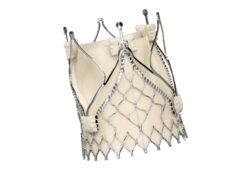Two studies with the longest yet follow-up periods comparing the sirolimus-eluting stent with bare metal devices for myocardial infarction patients were presented during Late Breaking Clinical Trials sessions at the EuroPCR congress, in Barcelona, Spain. STRATEGY and TYPHOON showed sustained benefits for the Cypher stent after five and four years, respectively.
TYPHOON study
Christian Spaulding, Professor of Cardiology, Assistance Publique-Paris Decartes University Hospitals, Paris, France, presented results from the TYPHOON (Trial to assess the use of the Cypher stent in acute myocardial infarction treated with balloon angioplasty) study, the first large, randomised, multicentre clinical trial to study the safety and efficacy of the sirolimus-eluting stent (Cypher, Cordis) in patients who have suffered a heart attack. In Spaulding’s opinion, the drug-eluting stent performance shows the use of device for myocardial infarction is “warranted in clinical practice”.
The primary endpoint was target vessel failure (a composite of target revascularisation, re-infarction and cardiac death). At one year, there was 50% reduction target vessel failure (7.3 vs. 14.3, p=0.004).
TYPHOON closed by study design in 2006, after one year of follow-up. Due to concerns about stent thrombosis, the trial re-opened in 2007 to ascertain four-year follow-up data. TYPHOON was conducted at 48 sites across Europe, Israel and Australia.
Four years post-implantation, patients receiving Cypher remained 53% less likely to experience target lesion revascularisation than those receiving a bare metal stent. Specifically, patients in the Cypher arm had a target lesion revascularisation rate of 7.2% vs. 15.2% with bare metal stents (p=0.005). The reduction of target vessel revascularisation (TVR) by the Cypher was also maintained with a 44% reduction at four years compared with BMS: 9.6% vs. 17.2% (p=0.013), respectively. There continued to be no differences in the key safety parameters of cardiac death, infarction or stent thrombosis in the four-year follow-up.
There continued to be no differences in the key safety parameters of cardiac death, heart attack or stent thrombosis in the four-year follow-up – the death rate was 4% for Cypher vs. 6.4% for the BMS.
These findings do not support earlier concerns on the long-term safety and efficacy of the sirolimus-eluting stent in primary angioplasty for infarction, according to Spaulding. The reduction in repeat revascularisation provided by the Cypher stent, he said, is maintained without an increased safety risk during long-term follow-up.
“The four-year results of this trial, especially the highly significant reduction in TVR, are impressive because of the sustained benefits seen in these patients receiving the Cypher Stent,” said Spaulding. “These results will be helpful to physicians as they assess treatment options for patients having an acute heart attack.”
Prior to TYPHOON, there were insufficient randomised clinical data available to evaluate the safety of a drug-eluting stent during the acute phase of a heart attack. There were numerous clinical trial data assessing the safety of bare metal stents in these patients. At four years, there were no differences in rates of ARC (Academic Research Consortium)-defined definite/probably stent thromboses between the two treatment arms (4.8% for Cypher vs. 4.4% for bare metal stents; p=0.83).
“The safety outcomes for the Cypher stent in this complex patient population were similar to what we have seen in the BMS arm,” said Spaulding.
In August 2008, Cypher Select Plus, which is available outside the US and Japan, received CE mark for infarction. TYPHOON one-year data were published later that year in the New England Journal of Medicine. Cordis sponsored the trial.
Five-year outcomes of DES vs. BMS
Carlo Penzo presented findings on the five-year safety/benefit profile of sirolimus-eluting stent (SES) compared with traditional bare metal stent implantation in patients undergoing treatment with glycoprotein IIb/IIIa inhibition for STEMI. The trial formed part of a prespecified analysis of the STRATEGY (Single high-dose bolus tirofiban and sirolimus eluting stent versus abciximab and bare metal stent in acute myocardial infarction) trial, a single-blind, randomised, controlled study of 175 STEMI patients at a single referral centre.
At five years, the primary endpoint consisting of the composite of death, myocardial infarction, stroke or binary restenosis remained lower in the sirolimus stent group (30% vs. 51%, p=0.006). The cumulative incidence of death, infarction or target vessel revascularisation was lower in SES arm. All-cause mortality and the composite of death or infarction was similar in the SES vs. the BMS group (p=0.70 and p=0.58, respectively), while the need for target vessel revascularisation remained markedly reduced (10.3% vs. 26.1%, p=0.007) in the drug-eluting stent group. The cumulative incidence of definite, probable or possible stent thrombosis was 6.9% in the SES vs. 7.9% in bare metal stent group (p>0.99).
Penzo concluded, “At five-year follow-up, a strategy of SES implantation in patients undergoing treatment for STEMI remained superior in terms of re-intervention in the infarcted artery, compared with bare metal stent and also with no safety concerns.”
“The four year results of TYPHOON and five year follow-up of the STRATEGY trial clearly show that the benefit of the Cypher stent on the reduction of repeat revascularisation is maintained on a long-term basis. Most importantly, there is no long-term safety issue with any difference in death, repeat myocardial infarction and stent thrombosis between bare metal and the Cypher stents. The use of Cypher during primary PCI for AMI is therefore warranted in clinical practice,” Spaulding told Cardiovascular News.
HORIZONS-AMI published
The landmark trial comparing the safety and efficacy of drug-eluting stents and bare metal stents was published in May in the New England Journal of Medicine. The study, HORIZONS-AMI (Harmonizing outcomes with revascularization and stents in acute myocardial infarction), showed that in heart attack patients undergoing angioplasty, the use of paclitaxel-eluting stents (Taxus Express2, Boston Scientific) reduces rates of target lesion revascularisation (TLR) and binary angiographic restenosis when compared to the use of bare metal stents after one year.
Additionally, the primary safety measure of major adverse cardiovascular events, including death, re-infarction, stent thrombosis and stroke established the non-inferiority of drug-eluting stents with respect to safety through one year.
The study, led by Gregg W Stone, of the Cardiovascular Research Foundation and professor of medicine at Columbia University Medical Center/New York-Presbyterian Hospital, was sponsored and managed by the Cardiovascular Research Foundation with research grant support from Boston Scientific Corporation and The Medicines Company.
The use of paclitaxel-eluting stents resulted in a significant reduction of ischaemia-driven TLR at 12 months (4.5% vs. 7.5%). TLR was the primary efficacy endpoint of the trial.
The use of paclitaxel-eluting stents also resulted in a significant reduction in binary restenosis after 13 months, which is the rate at which the artery re-narrows at least 50% following implantation of the stent, and was the secondary efficacy endpoint of the trial. The paclitaxel-eluting stent had a rate of 10% and the bare metal stent had a rate of 22.9%.
“Outcomes from prior registry and randomised trials of drug-eluting stents compared to bare metal stents in heart attack patients have been conflicting. These results now provide definitive evidence that paclitaxel-eluting stents are superior in efficacy to bare metal stents and have a comparable safety profile at one year,” said Stone. “The findings from the HORIZONS-AMI trial will have a major impact on how decisions are made regarding drug-eluting and bare metal stents in the highest risk patients, those in the early hours of a heart attack. This study removes much of the uncertainty and concern about the efficacy and safety of drug-eluting stents in this clinical setting. Moreover, all of the patients in this trial will be followed long-term to ensure that these favourable results are maintained.”
The HORIZONS-AMI trial, a prospective, multicentre, controlled study, enroled 3,602 heart attack patients at 123 centres in 11 countries, 3,006 of whom were randomised to paclitaxel-eluting stents versus identical bare metal stents. Taxus Express and Express are not indicated by the FDA for use in patients with AMI.










